Royal Arcerion Naval Service
| Royal Arcerion Naval Service | |
|---|---|
| Arcer Navy | |
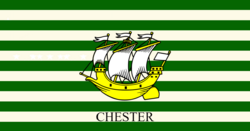 Ensign of the Royal Arcerion Naval Service | |
| Country | |
| Type | Navy |
| Role | Naval warfare, power projection, Humanitarian aid/intervention, Coastal defense, maritime law enforcement, search and rescue, and sealift |
| Size | 561,647 personnel |
| Part of | Armed Forces of Arcerion |
| Garrison/HQ | HMANS Chester-on-Moore |
| Nickname(s) | Fort Chester |
| Motto(s) | From Chester to Dunaird |
| Colors | Green, White, Yellow |
| March | Pine Bough March |
| Anniversaries | 6 January, 1805 (founding) |
| Engagements | Arcer Bush Wars |
The Royal Arcerion Naval Service, also referred to as the Arcer Navy, is the seaborne military component of the Armed Forces of Arcerion. It was initially founded by the King of Ardmore through a Royal Decree in 1805 as the Arcer Cutter Service, and later was renamed to its current name. It is one of the oldest professional navies in Crona, and draws much of its history and heritage from its predecessor, the Royal Ardmori Navy. It played a significant role in the Second Great War, and its expansion afterwards into the Occidental Cold War meant that it saw frequent deployments in the Malentine and Songun Seas, as well as the Odoneru Ocean to interdict weapons and smuggled equipment during the Fourth Bush War. The Navy today is a modern fighting force that assists with ensuring freedom of navigation and maritime security, serving as one of the main methods of power projection in Arcerion.
Role
History
Colonial Expeditionary Escorts
Arcer Cutter Service & Founding
19th Century to 20th Century
Second Great War
Modern Period
RANS Today
Main Article: Structure of the Royal Arcerion Naval Service
Mission
The Royal Arcerion naval Service's main objective is the protection of Arcer maritime sovereignty, assisting with power projection, and ensuring the continuance of maritime commerce through Arcer and international waterways in times of war. It regularly trains in core competencies as a primarily green-water Navy, focusing on tasks such as area and sea lane denial, mine warfare (both mine laying and mine countermeasures), maritime patrol, and subsurface warfare (encompassing both submarines and anti-submarine warfare). One of the implied tasks that comes from the Navy's mission statement revolves around the continuance of maritime commerce to Arcerion during a period of armed conflict, meaning that Arcer ships must be adept at both convoy escort, patrol, and surface-surface/surface-to-air warfighting at sea.
Personnel
His Majesty's Arcerion Naval Service Station Port Hughes serves as the basic training facility of Arcerion's sailors and naval officers. While naval officers will complete their academic education at the Royal Arcerion Military College, their practical seafaring and leadership education is done through HMANSS Port Hughes. After initial intake and testing, personnel are separated into multiple service streams, from Naval Warfare, to engineering and logistics, depending on their suitability based on entry testing and fitness. Officers and enlisted members who wish to join the Arcerion Regiment of Marine Commandos also self-identify during this period so they can attend Assessment and Selection programs after their initial training phase.
Surface Fleet
See Also: Active Ships of the Royal Arcerion Naval Service
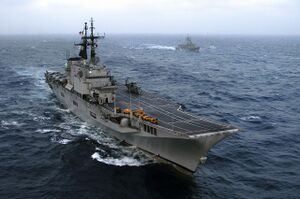
Aircraft Carrier
The RANS only has one remaining aircraft carrier, the ACS Kurst. With an original unit cost of £1.319b Arcer Pounds, and it displaces 9,900 long tons before combat loading. It was laid down in 1984, and launched in 1987, commencing and completing flight trials the same year, being declared operationally ready for sea trials in 1988. It was commissioned in 1988 in Chester-on-Moore, and has remained as the flagship of the Arcerion Navy since then, when it took over the title from the destroyer ACS Windswept. The Kurst is the central piece of Arcerion's expeditionary naval force and represents the central component to both the Naval Air Service and Arcerion Carrier Group 1, the nation's only full-time blue water expeditionary strike group along with its escorts and support ships.
Amphibious Warfare and Anti-submarine Warfare
Arcerion maintains a larger component of 'flat-top' ships for conducting expeditionary operations supported by helicopters, which became a central part of Arco Naval doctrine after liaisons attached to the Army during the Fourth Bush War identified their use for troop deployment using vertical envelopment. This coincided with an increased emphasis on the Navy during the 2022 Confederate Memo on Defence, which outlined the need for two additional helicopter carriers to join the fleet to support international operations. The main capability for this is a trio of ships, the Nathaniel-class Landing Platform Docks, and the Future Helicopter Expeditionary Support Ship Program (FHESSP) which is undergoing evaluation for a contract awarding and ship construction to begin no later than 2027. While the primary role of the Nathaniel-class is to conduct expeditionary operations, they are primarily meant for supporting expeditionary and humanitarian missions.
The Navy also maintains the most robust anti-submarine warfare capability in the Malentine and Songun Seas. The majority of this is provided by the three Nathaniel-class LPDs and their on-board maritime helicopters, but there is dedicated surface vessels that also complement the task. This is accomplished by the older Gibson-class Frigates, of which six are still in service.
Clearance Diving and Mine Warfare
Arcerion Naval Clearance Divers are Ixnay leaders in Explosive Ordinance Disposal (EOD) and mine defusal. Clearance Divers are trained at His Majesty's Arcerion Naval Service Station Port Gibson, Foxhey Governorate, at the Explosive Threat and Management School (ETMS), which is run jointly with members of the Royal Arcerion Engineers from the Arcer Army. Clearance Divers also provide detachments to Arcerion Special Operations Command for maritime special operations.
For mine hunting, minesweeping, and minelaying, the surface fleet has two dedicated ship classes to conduct such activities. The primary mine hunter and minesweeper for the RANS is the Rockenborough-class, numbering five ships, and the three-ship Bradford-class minelayers representing the offensive and sea denial capability for Arcerion. The Submarine Service also includes a limited amount of ocean floor and seafloor minelaying capability, but these have not been officially disclosed by the Arcer Government.
Escort Fleet
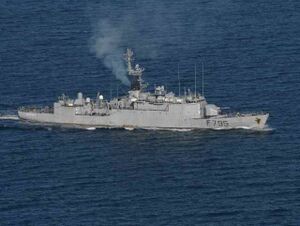
The escort fleet comprises the surface fleets main naval warfare vessels. It is comprised of guided missile destroyers and frigates and is the Navy's main effort for procurement, life cycle management, fleet upgrades, and support. Arcerion has seven destroyers (Warrington-class) and sixteen frigates (Panomes-class) in active service. The primary function of these vessels is twofold, the first to provide escort and screening functions for the larger capital ships - keeping them shielded from air, sea, and undersea threats. The destroyers and frigates of Arcerion also represent the major deploying forces for expeditionary sea missions and standing deployments such as counter-narcotics and counter-piracy missions. The eight Warrington-class provides much of the fleet's horsepower for anti-aircraft and missile defence tasks, utilizing its wide array of integrated anti-air systems, close-in-weapons systems (CIWS), combining them with advanced long distance search and target acquisition radars. Whereas the Foxhey-class are the 'shield' for the fleet's capital vessels, the Panomes-class are the 'sword,' or the primary offensive vessels in the fleet. Utilizing several different kinds of long-range torpedoes and anti-ship missiles (AShM), they provide a deterrent against hostile vessels and are primarily used to screen and harass enemy surface vessels.
The Panomes-class are slated to be replace by the Arco-Burgoignesc Patrol Corvette and Aviso program, which will assume patrol and escort vessel duties, the remaining Panomes class to be refitted as anti-submarine vessels.
Patrol Fleet
The Patrol fleet maintains Arcer maritime sovereignty in littoral areas and projects power into contested sea lanes such as the Warrington and Songun Straits. This capability is currently represented by fourteen Hughes-class corvettes, which are scheduled to be replaced by the Arco-Burgoignesc Patrol Corvette and Aviso program's Warrington-class.
Oceanographic Ships
Arcerion maintains three scientific and research ships for the navy. ACS Howland is the nation's arctic exploration and survey vessel, named for the renowned Arcer explorer Sir John Howland. It also maintains a pair of sister ships, the Emily and Forthright, named for some of the mythic Arcer arctic exploration vessels from the turn of the century.
Arcerion Merchant Marine

The Arcer Merchant Marine provides a hybrid military and civilian support structure for the Arcer Navy. It consists of four fleet tankers, two solid support freight ships, and two expeditionary support ships, which are primarily aimed at providing roll-on roll-off capability for the Arcer Army.
Submarine Service
The Submarine Service, often referred to as the 'Silent Service' is a major offensive and sea denial component in the Arcer security strategy. It is comprised of two classes of diesel-electric submarines, and was founded in 1917 with the adoption of the first submarines into the Arcer Navy. All of Arcerion's submarines are considered SSKs, or fleet attack submarines, designed to operate in the Malentine and Songun Seas, with a limited ability to conduct power projection operations into the Polynesian Sea through the Songun Straits. The Submarine Service also has the capability to conduct sea lane denial, using torpedoes, undersea-launched cruise missiles, and various types of sea mines. Submarines also operate on conjunction with the Arcerion Special Operations Command (ASOC), to insert and extract special operations teams, conduct strategic reconnaissance and gatehr signals and electronic intelligence using advanced sensor suites. They are also capable of using their integral land-attack cruise missiles in a conventional first-strike capability against a peer opponent.
As of 2026, the navy operated eight attack submarines, three of them the older Dolphin-class, and five the newer Sea Lion-class. The majority of these were deployed in the Songun Area of Operations (SAO), however news reports stated that the ACS Sea Lion, the lead ship of the newest Arcer submarine class, was spotted docked in Howland Governorate conducting Arctic Sea Trials and ice shelf breaching operations.
Arcerion Regiment of Marine Commandos
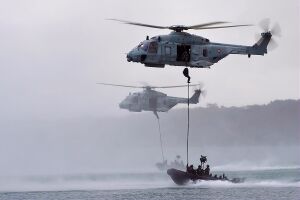
The Arcer Naval Register is the active list of commissioned ships in the Royal Arcer Naval Service. As of 2026 the Register indicated the following:
- Aircraft Carriers, 1
- Landing Platform Dock Ships, 3
- Anti-submarine frigates, 6
- Mine warfare vessel, 5
- Mine layers, 3
- Guided missile destroyer, 7
- Patrol Frigate, 16
- Corvette, 14
- Support Ships, 8
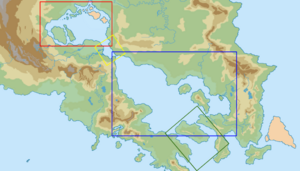
Key Areas
Warrington Strait
Main Article: Warrington Strait
The Warrington Strait remains a key choke point both for military and commercial vessel navigation in the Malentine/Songun Seas. The continued patrol and defense of the Warrington Straits reflects the importance of it economically not only to Arcerion, but also to the wider international community that borders on the Malentine Basin. The Strait forms a natural canalization and is responsible for some of the highest rates of maritime traffic in Ixnay, and the Royal Arcerion Naval Service works with large corporations and maritime navigation authorities to ensure that it remains a safe passageway for freighters, oilers, and large container ships.
Songun Strait
Foxhey Islands
Istrenyan Coast
Howland Governorate
Crona
Arctic
Foreign Bases
 Fort St. Michel, Equitorial Ostiecia, Burgundie
Fort St. Michel, Equitorial Ostiecia, Burgundie
Joint Bases
Command and Control
Current Deployed Operations
International Engagements, Relationships, and Partnerships
Arco-Burgoignesc Partnership
Arco-Stenzan Exercises
VIGILANT SEAFARER Series
Heraldry and Titles
Ships, Stations, and Formations
Ships in Arcerion follow two distinct naming conventions, those being pre-Ardmori Revolution, and post-Ardmori Revolution. Ships, stations, and formations that were established, named, or decreed prior to the Ardmori Revolution and the dissolution of the Ardmore Monarchy are given the prefix "Royal." In the cases of sailing ships and submarines, this meant the historical use of His/Her Majesty's Arcer Naval Ship (HMANS). However, after the Ardmori Crown ceased to exist, it now only remains as the historical and figurative figurehead of the Navy. Modern ships (usually post-Second Great War), are given the prefix Arcerion Confederate Ship (ACS). Shore installations are similar in nature, with pre-war names indicating their Crown-affiliation. The naming convention follows ships, as in Royal Arcerion Naval Service Station (RANSS) or His/Her Majesty's Arcerion Naval Station (HMANS), and the two are considered interchangeable. Post-war institutions have a variety of names, with no set prefix, for example, the Arcer Navy Testing and Research Centre (ANTRC) which tests and conducts weapons evaluations was created in the 1960s therefore has no Royal Affiliation.
In Popular Culture